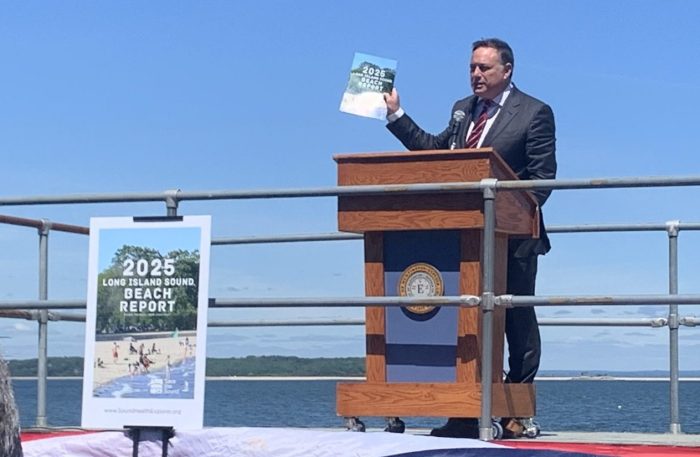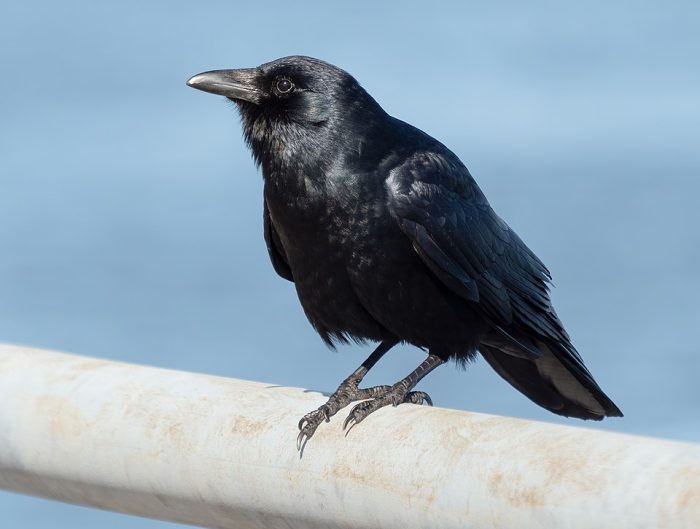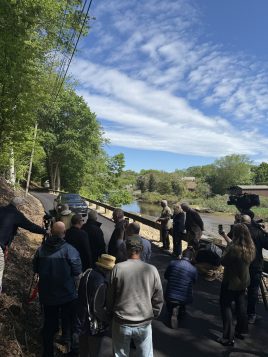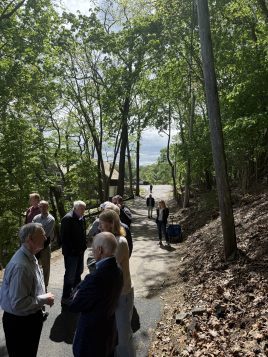By Sabrina Artusa
Nine months after 9 inches of rain blew out the Stony Brook Mill Pond dam, rupturing Harbor Road and draining the Mill Pond, residents organized in front of the cracked asphalt and marshy hollow to urge reconstruction.
Politicians from the Town of Brookhaven and Head of the Harbor as well as members of Ward Melville Heritage Organization were present at the two-hour rally on May 31 and fielded questions of ownership, Federal Emergency Management Agency reimbursement and a potential timeline.
The lack of progress is due to ownership disputes, with both Brookhaven officials and Ward Melville Heritage Organization President Gloria Rocchio stating they don’t own the road.
Beth Zweig, a Head of the Harbor resident who helped organize the rally, said, “I noticed nothing was happening and… really just wanted to get an update on where things were.” After communicating with other residents and Head of the Harbor Mayor Mike Utevsky, Zweig learned of the “bureaucratic roadblock.”
“The residents are not happy and we won’t accept a stalemate,” Zweig said. “If it is a stalemate we aren’t going to make any progress.”
Originally, the TOB thought it did own the road and began setting aside funds, said Councilmember Jonathan Kornreich (D, Stony Brook), before a title report produced by the town’s attorney proved the town does not own the road. An easement agreement signed by Rocchio corraborates the report and was presented at the rally. The 2007 contract allowed the Paul Simons Foundation permission to build a paved walkway on Harbor Road.
Rocchio is working with her own attorneys and says her organization is not responsible for the road. She said the organization doesn’t own roads, except for Mill Creek Road.
“There is no real danger of an outlay of money and not getting that money back; we have been reassured by the state of New York that reimbursement will be made,” TOB Supervisor Dan Panico (R) said. He continued, noting federal trends with funding. “Right now we are guaranteed 75% reimbursement. In the future, we may be looking at zero.”
He went on to say that, as the ecosystem begins to rebound, the argument against replacing the dam and letting the area grow may gain momentum.
Many residents, particularly those from Head of the Harbor who lost their main passageway to their residences, are concerned about access to emergency services.
“It is an ecological disaster. It is a medical crisis waiting to happen because there are so little ulterior roads to service the villages,” said Mickey Conlon.
“All it’s going to take is one person to die because an ambulance can’t get in and something is going to happen,” said Tom Postillo, who frequently visited Mill Pond.
“This is the village center, not only for residents, but for tourists who bring a great deal of business,” said another resident.
Head of the Harbor Mayor Michael Utevsky said that the entities have been in a lock for months and that at “every meeting it seemed there is something about to happen” but a solution never came to fruition.
Some residents felt that a go-around must exist and hoped the entities could work together. Kornreich and Panico said it was impossible for the town to expend taxpayer money on private property.
“I am paying an enormous amount of taxes to Brookhaven, to Suffolk County, to New York,” said Laura Sclafani, a Stony Brook resident. “Why aren’t they paying?”
Sclafani said she is grateful for how the organization preserved the land. “They keep [the village center] great. I don’t want them bankrupt,” she said.
“We need the owner to do this. We would love to do this. If there is a title report that says the town owns it, give it to me today and I will sign it tomorrow, so we can make a straight-faced application to FEMA before they go out of business,” Kornreich said.
“I think today was very productive, we got to know each other more,” Rocchio said. “I think the myths have been eliminated.”





























